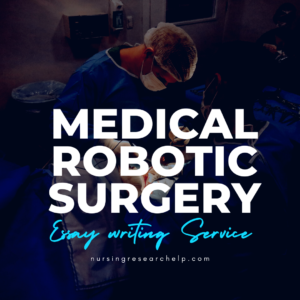What Is Robotic Surgery?- Essay Help

What Is Robotic Surgery? Robotic surgery is a type of surgical procedure that uses robotic systems. It has been developed to enhance the capabilities of surgeons performing open surgeries. In the past, it was used to perform minimally invasive surgery, but now, it has been expanded to a variety of procedures.
First used in surgery in the 1960s
Robotic surgery is the use of computerized devices to perform surgical tasks. In addition to the improved precision, ergonomics, and kinematics that robotic surgery offers, it can also reduce the stress and anxiety of the surgeon.
Although it has been around for over 30 years, robotic surgery has only recently begun to receive widespread attention in the healthcare sector. As the technology continues to evolve, robotic surgeons will gain greater confidence in its ability to improve patient outcomes. It is important that surgeons and medical professionals understand the benefits and risks of using a robotic device in their operating rooms.
While robots are not yet performing as many surgeries as their human counterparts, the first robotic surgical systems lacked the dexterity and flexibility that most surgeons require. They could only manipulate instruments with at most four degrees of freedom (DOFs) and required human review.
However, the demand for robotic surgery increased when surgeons began to adopt minimally invasive surgical technologies. These techniques reduced wound access trauma and postoperative complications. Additionally, they offered a faster hospital stay and discharge.
Several companies were actively working on developing robotic surgical systems. Some of them included SRI International, Computer Motion, and the Defense Advanced Research Projects Agency.
Computer Motion’s AESOP technology was the first surgical robot approved by the FDA. This system was also the first voice-controlled equipment used in an operating room.
The success of the AESOP robotic system marked the beginning of robotic surgery globally. It became the standard of care and was adopted in more than 1,000 hospitals worldwide.
Although robotic surgery has received some resistance from the healthcare industry, the industry has also demonstrated its support for new entrants. By sharing costs, institutional partners can help expand the financing of robotic surgery and make it more widely accessible.
Future integration of robotic systems promises tactile feedback and integration with advanced imaging technologies. These capabilities may allow the system to modify the surgical environment.
With robotic surgery, the goal is to combine the advantages of a minimally invasive approach with the enhanced precision and efficiency that robotics offer. More evidence and better training will allow surgical teams to gain more confidence in using robotics.
Has become the entry fee for centers wanting to be known for excellence in minimally invasive surgery
Robotic surgery is one of the most popular minimally invasive techniques today. The advantages of minimally invasive surgery include shorter hospital stays, less pain and scarring, and faster recovery times. This technique is being used by surgeons to treat a wide variety of conditions.
Surgical robots can integrate with several operating room technologies to improve the safety and quality of surgical care. These include preoperative imaging, computed tomography and intraoperative image fusion.
Unlike traditional open surgeries, robotic surgery uses minimally invasive procedures and tiny incisions to carry out the procedure. In this way, the risk of infection is reduced, and there is less blood loss. Patients can return to normal activities within 24 hours of surgery.
While there are many benefits to minimally invasive surgery, a number of disadvantages can also be found. A common problem is the lack of compatible instruments. As a result, a greater amount of tableside assistants may be required.
For example, robotic surgery can help surgeons perform complex surgeries with greater precision and dexterity. Surgeons can operate with greater ergonomic comfort and can see a clearer image than they would in traditional surgeries. However, these advances have come at a price.
Currently, there are more than a handful of hospitals in the US that have achieved a center of excellence in robotic surgery. Some of these institutions have even been recognized for their patient safety and technology innovation.
In fact, the Center of Excellence in Robotic Surgery at Tampa General Hospital recently performed the 10,000th robot-assisted surgery. This makes the center one of the top 50 in the United States in several specialties.
Other centers, like the Center for Minimally Invasive Surgery at Monmouth Medical Center, have implemented robotic surgery quickly. The center is now the region’s leading provider of laparoscopic and robotic procedures.
Regardless of the benefits and drawbacks of robotic surgical systems, their adoption has been driven by the market. As more institutions acquire the devices, more and more surgeries will be performed using these systems.
Robotics have revolutionized the surgical industry. Today, it is the new entry fee for centers that want to be known for their excellence in minimally invasive surgery.
Allows surgeon to remain seated comfortably and guide the robot’s hands with ease
Surgical robots are used by many surgeons in the operating room. They help the surgeon perform complicated surgeries with greater precision. This allows them to reach difficult areas without the pitfalls of conventional laparoscopy.
One example of a surgical robot is the da Vinci robotic surgery system. The system combines seven degrees of freedom with high-definition 3D vision. It is capable of performing a range of minimally invasive procedures, including coronary artery bypass, thoracic surgery, colorectal surgery, and prostate surgery.
The system is based on an open architecture. Each of its four arms are mechanically balanced for safety and ease of use. In addition, the systems’ instruments are positioned under direct vision of the trocar by a camera attached to the robotic arm.
Surgeons can operate in comfort and remain focused during the operation. They can also keep the ideal hand position as the operation progresses. There is still a small risk of human error.
The robotic surgery arm has been in development for five years. It will begin its work in hospitals in 2020.
The technology has been approved by the U.S. Food and Drug Administration (FDA) for general laparoscopic surgery and cardiac procedures. It has also been approved for gynecologic and prostate surgeries.
Robot-assisted surgery is expected to help surgeons find tumors, set bones, and close wounds. In fact, the next generation of surgical robots could even be able to hold a camera during the operation.
Modern robotic technologies can provide surgeons with tremor-free dexterity and true 3-D HD visualization. In addition, the system is able to give a sterile field of view, using custom-fitted plastic drapes.
With the help of modern robotic technologies, surgeons can perform minimally invasive procedures with more precision than they have ever had before. While the learning curve is a bit steep for advanced abdominal procedures, it is not impossible to get up to speed.
Some surgeons are already incorporating the da Vinci system into their practice. The company hopes to expand the system into underserved areas.
The Senhance Surgical Robotic System was the first digital surgery system to be cleared by the FDA for the use of tiny instruments on a robotic interface. It has also been the first to be equipped with haptic feedback.
Can expand surgical modalities beyond the limits of human ability
Robotic surgery offers a variety of benefits for surgeons and patients. Minimally invasive procedures have been shown to reduce the risk of complications and the length of hospital stays. In addition, robotics provide long-distance intraoperative guidance.
The da Vinci Surgical System is one of the most widely used robotic surgical platforms. It was developed by Computer Motion, Inc. After the FDA approved the da Vinci system in 2011, the market expanded rapidly. With more institutions and hospitals purchasing robots, the number of surgeries performed using robotics has also increased.
However, the da Vinci system is quite expensive. Each robotic system costs about two million dollars. Currently, it is the most common robotic modality used in the United States.
Despite its high price, the da Vinci system is designed to provide surgeons with a comfortable user experience. It offers motion scaling and 3D visualization. These features enhance the surgical precision of physicians.
Compared to open surgical approaches, robot-assisted surgery provides enhanced view, speed and dexterity. However, it is not yet clear that the use of robotics in surgeries is as effective as it could be. There are still many research and development obstacles to overcome before the use of robots is as widespread as it can be.
Research is progressing towards micro-scale robotic platforms. Microbots are small, sub-millimeter constructs that are able to carry out a designated task without touching the patient’s skin.
Micro-scale robotic platforms may represent a potential path toward smaller and more compact surgical robots. A number of research groups are currently collaborating to develop surgical autonomy. While the level of automation is not yet at a fully autonomous level, supervised and unsupervised modes are promising.
Although more studies are needed to determine the efficacy of automation in robotic surgery, more clinical trials are needed to evaluate its effectiveness. Another important goal is to ensure that safety standards are met for autonomous surgical robots.
The development of robotic surgery systems has expanded rapidly due to the popularity of minimally invasive surgery and the opportunities it presents. Moreover, there are many technologies that can help promote the evolution of the surgical system toward full automation.



